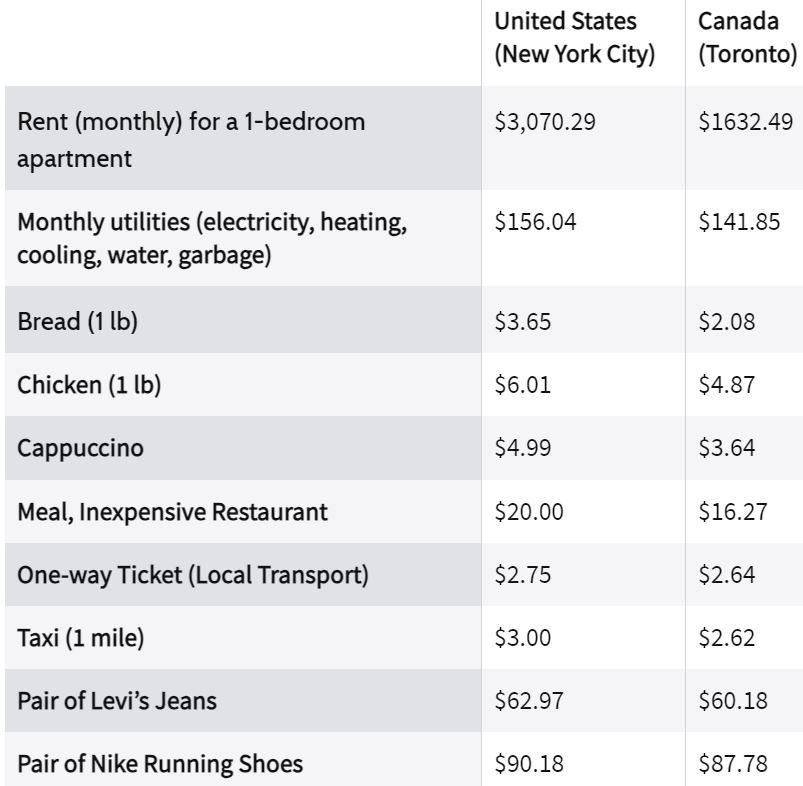The timeless debate of whether to move to Canada or the United States has intrigued many for generations. Both countries offer unique qualities and advantages, and deciding where to live is a complex one. In this comprehensive comparison, we will explore various aspects of life in Canada and the USA, shedding light on key differences and similarities that can help you make an informed choice.
Key Differences Between USA and Canada
Culture
The beautiful diversity of cultures between Canada and the United States, though nuanced, adds a special richness to each country. Canadians are widely recognized for their remarkable politeness, a quality ingrained in the very fabric of their society. This kindness often shines through in their focus on collective harmony and a natural inclination to apologize – a wonderful departure from the more assertive individualism often seen in the United States. Canada’s strong commitment to multiculturalism stands out, championing diversity and inclusivity. On the flip side, the United States, while also wonderfully diverse, tends to emphasize the “melting pot” idea, encouraging the blending of various cultures into a cohesive American identity. Despite these differences, both nations share a history and values rooted in democracy.
Cost of Living in Canada vs USA
Considering the cost of living is a pivotal factor. On average, living in the USA tends to be more expensive compared to Canada. However, it’s vital to understand that these costs vary significantly within each country. While some expenses may be higher in Canada, such as food and real estate, the USA faces higher costs in areas like healthcare and education.
Living in major cities across both countries can be costly, but when making a cross-border comparison, the USA emerges as the pricier option. Groceries, rents, and restaurant prices generally run higher in the USA than in Canada. Nevertheless, clothing in the USA is often more budget-friendly, and wages are generally higher. It’s essential to consider that Canada has higher taxation rates than the USA, which can influence the overall cost of living. Despite this, depending on your circumstances, the USA might still prove to be the more affordable choice.

Healthcare
Healthcare is another significant factor to weigh when deciding between Canada and the USA. The United States has the highest healthcare costs globally, with individuals spending an average of approximately $11,172 per capita annually. Access to healthcare is often tied to employment, with many Americans obtaining health insurance through their employers. This system can lead to variations in coverage and accessibility, with individuals without insurance facing challenges in obtaining affordable healthcare. The Affordable Care Act (ACA) has expanded coverage for many Americans, but disparities in access and affordability persist.
In contrast, Canadians spend about $7,064 per capita on healthcare. While the US offers access to some of the world’s finest medical facilities, many Americans struggle to afford quality healthcare. In Canada, healthcare is publicly funded, with the government covering a significant portion of medical expenses through taxation. This results in a universal healthcare system, providing all residents with access to essential medical services without the burden of high out-of-pocket costs. Canadians typically have a primary care physician who serves as a gateway to specialized services.
Education
The education systems in both the USA and Canada share similarities, with state education being prevalent in both. However, differences emerge in their university systems. In Canada, tuition fees are notably lower than in the USA, offering a more affordable option for students seeking higher education. The USA boasts numerous prestigious private universities, including Ivy League institutions, but attending these institutions can come with a hefty price tag. Scholarships and financial aid opportunities are available in the USA, which can help mitigate costs. The choice between the two countries ultimately depends on your educational goals and financial situation.
Climate and Nature
The United States and Canada boast vast and diverse landscapes, providing varying climates and natural beauty. The USA, being closer to the equator, generally experiences warmer weather and higher population density than Canada. However, Canada offers its unique natural wonders and outdoor recreational opportunities, appealing to adventure enthusiasts.
Average Daily Maximum Temperatures per Year

The disparity in climate between Canada and the United States is significant and varies widely across the vast expanse of both nations. Canada, known for its diverse climate, experiences colder temperatures on average compared to the United States. The northern regions, such as Yukon and the Northwest Territories, endure harsh winters with temperatures well below freezing, while southern areas like Vancouver and Toronto enjoy milder climates. Canada also witnesses substantial amounts of snowfall, especially in the central and eastern provinces during winter months, contributing to the iconic winter landscapes. Among the largest cities in Canada with the greatest amount of snow per year, the top five are St. John’s, Saguenay, Québec City, Sherbrooke, and Moncton.
In contrast, the United States exhibits a more varied climate due to its extensive geographical diversity. Regions like Alaska and the northern Midwest endure harsh winters akin to Canada, with substantial snowfall. However, the southern states generally experience milder winters and warmer temperatures. The U.S. weather patterns also include areas with high rainfall, such as the Pacific Northwest, and arid regions, like the southwestern states, experiencing lower precipitation.
Immigrants heading north should be ready for colder temperatures and the potential for substantial snowfall, depending on the specific region within Canada.
Languages
Language distinctions between Canada and the United States, albeit subtle, mirror the unique linguistic fabric of each nation. While English functions as the primary language in both countries, Canadians occasionally embrace British English spellings, providing a delightful departure from American conventions. The bilingual nature of Canada, particularly evident in Quebec, introduces French as an official language, adding to the country’s linguistic diversity.
In contrast, the United States predominantly adopts English without notable regional linguistic influences. Despite English being the official language, various languages have emerged as the most spoken in the United States, primarily due to immigration. In 2019, Spanish took precedence as the most prevalent non-English language spoken in U.S. households, constituting 62%. This surpassed the next four most common languages: Chinese, Tagalog, Vietnamese, and Arabic.
Recognizing and appreciating the linguistic diversity within each province can enhance effective communication and elevate the experience for individuals seeking to reside in the francophone side of Canada. This not only increases your job prospects but also enhances opportunities to interact more effectively with people from francophone cultures worldwide who are living in Canada
Visas and Immigration
The immigration process plays a pivotal role in your decision to move. The USA is renowned for its complex immigration system, which can be challenging to navigate. In contrast, Canada has a more streamlined system, particularly through the Express Entry points-based system, making it generally considered more accessible.
Lifestyle
Considerations of work hours, holiday time, and overall quality of life can also influence your decision. Canada offers generous work hours and holiday time, aligning more closely with European standards. Canadian air quality tends to be better, and Canadians have a longer life expectancy. Moreover, Canada boasts a high percentage of passport holders, allowing for easy international travel. In contrast, the USA may offer a faster-paced lifestyle, but air pollution is higher, and life expectancy is slightly lower. Factors like these contribute to lifestyle variations between the two countries.
Public Goods & Services
Access to public goods and services can significantly impact the cost of living. Canada provides universal healthcare, while healthcare in the USA often requires costly insurance. As for education, Canada has lower average university tuition fees, while the USA offers a broader range of institutions and programs.
Choosing Your North American Adventure
Ultimately, the choice between Canada and the USA depends on your individual preferences, priorities, and circumstances. Economic factors, including income, taxes, and the cost of living, play a significant role. Additionally, factors such as family benefits, healthcare, education, climate, culture, and immigration processes should all be considered when making this life-altering decision. Aligning your choice with your personal values, goals, and lifestyle preferences is paramount. Both countries offer exceptional opportunities, rich cultures, and exciting adventures, making it a challenging decision to determine where to call home.


